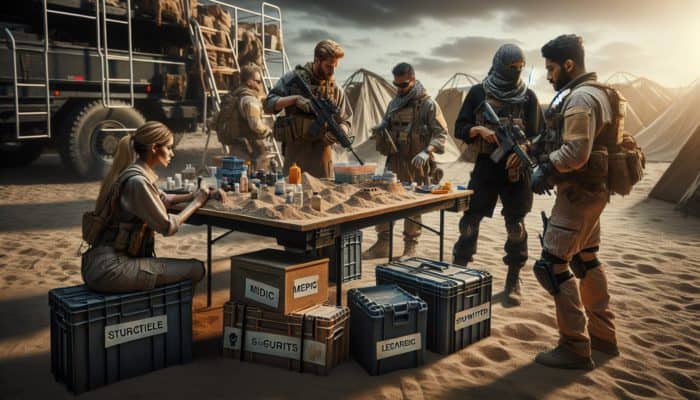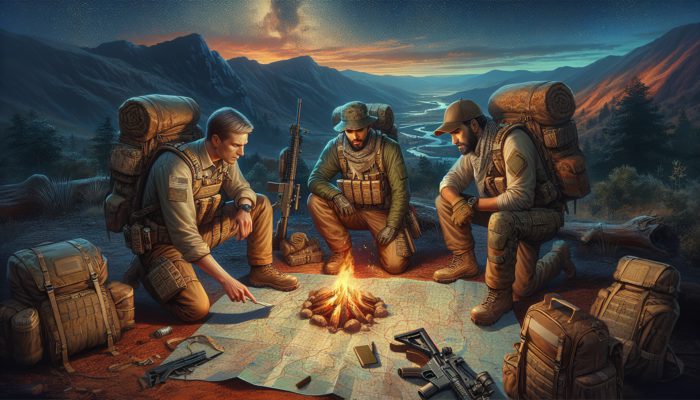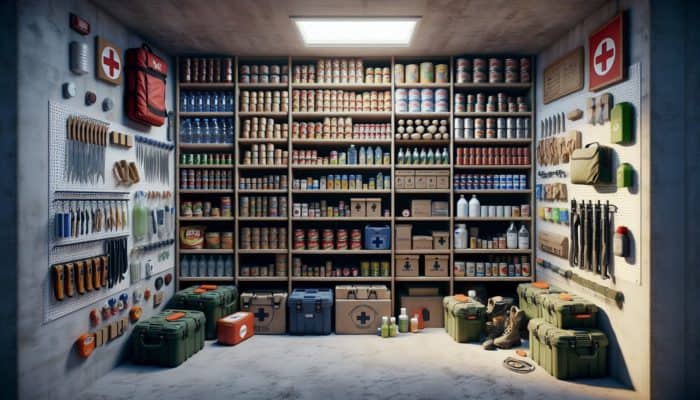Empower Your Prepper Team for Unmatched Emergency Readiness
Maximize Team Performance by Clearly Defining Roles and Responsibilities

To establish highly effective prepper teamwork, it is essential to define roles within the group clearly. This clarity allows each member to understand their specific duties, significantly enhancing the group's operational effectiveness. By designating distinct roles—such as team leader, medic, logistics coordinator, and security officer—the team can streamline operations and execute plans with precision. For instance, a logistics coordinator manages supply chains, ensuring that necessary resources are available, while a security officer focuses on protecting the team’s perimeter. It's crucial to regularly assess and update these roles based on the evolving skills of team members or changing circumstances to maintain high engagement and accountability.
Moreover, effectively communicating these roles during training sessions and meetings is vital for fostering a sense of ownership and commitment among team members. This empowerment enables individuals to take initiative in their areas of expertise. Participating in team-building exercises serves as an excellent method for clarifying these roles, allowing members to embody their responsibilities practically. This approach not only enhances team preparedness but also nurtures trust and collaboration, key attributes of any cohesive unit. Regular performance evaluations against these defined roles can spotlight areas needing improvement or further training, facilitating continuous refinement of the team’s operational efficiency.
Implement Robust Communication Strategies for Enhanced Team Coordination
Effective communication is the cornerstone of successful prepper teamwork. By establishing clear and reliable communication channels, team members can coordinate actions and exchange critical updates, especially during crises. Utilizing a blend of verbal and non-verbal communication methods can improve clarity and understanding. For example, team members could use hand signals during operations to reduce noise, while group messaging applications facilitate real-time updates and coordination among members.
In addition to technological solutions, implementing regular communication rituals—like daily briefings or weekly training sessions—can reinforce the team's operational framework. These gatherings create opportunities for members to voice concerns, share insights from personal experiences, and discuss upcoming drills. Fostering an environment that encourages open communication enhances the team's problem-solving and decision-making capabilities. Consider instituting a “communication buddy” system to pair members, ensuring messages are accurately relayed, thus improving the reliability of information exchange.
Another effective strategy involves creating a structured communication hierarchy. During crises, this structure channels messages through designated individuals, minimizing confusion and maintaining order. Establishing guidelines for when and how to communicate can alleviate stress, ensuring all team members feel informed and prepared. Regular drills that test these communication protocols guarantee their effectiveness and ensure every member is proficient in their use when it matters most.
Enhance Training and Skill Development for Ultimate Team Preparedness
Regular training sessions are pivotal for improving the capabilities of prepper team members, enabling them to respond effectively to a plethora of scenarios. Targeted training on essential survival skills—such as first aid, navigation, and food procurement—ensures each member can contribute meaningfully during a crisis. Incorporating team-building exercises is equally vital, as these activities foster camaraderie and trust, which are essential for a unified response to emergencies.
Utilizing diverse training methodologies keeps sessions engaging and impactful. For instance, hands-on workshops can impart skills like fire-starting and shelter construction, allowing team members to practice these techniques in a controlled environment. Additionally, employing scenario-based drills—where teams simulate real-life emergencies—provides practical experience that heightens overall readiness. This approach not only reinforces learned skills but also helps identify areas needing further training, thus promoting continuous growth.
Encouraging team members to pursue individual skill development further enhances group preparedness. Whether through local survival courses or online training modules, each member can contribute unique skills to the team. Establishing a mentorship program where seasoned members guide newer recruits also strengthens the team's capabilities. Ultimately, regular training and skill development create a knowledgeable, adaptable group that is well-equipped to tackle any emergency.
Key Strategies for Building Effective Prepper Teams

Identifying Essential Elements for Successful Prepper Teams
Successful prepper teams exhibit several key elements that contribute to their effectiveness. Leadership, trust, and adaptability are among the most critical factors shaping team dynamics. Strong leadership provides direction, ensuring that teams remain focused on their objectives during crises. For example, a leader capable of making swift decisions under pressure significantly influences the outcome of an emergency response. Leadership can take various forms, ranging from authoritative to democratic, depending on the situation and team dynamics.
Equally important is the trust among team members, which fosters an environment where individuals feel valued and are more inclined to collaborate effectively. Building trust can be achieved through regular team-building exercises that promote communication and understanding. For instance, survival retreats or workshops can help team members bond and cultivate mutual respect. Teams that prioritize trust operate more smoothly, especially during high-stress situations.
Adaptability is another vital component. Successful prepper teams must adjust their strategies to respond to changing circumstances. This may involve altering plans based on new information about a disaster or reallocating resources as necessary. Teams that practice flexibility through regular scenario planning and drills are better prepared for unpredictable events. By cultivating these three elements—leadership, trust, and adaptability—prepper teams can significantly enhance their overall effectiveness and resilience.
Effective Strategies for Building Trust Within Prepper Teams
Building trust among team members is fundamental for effective collaboration within any prepper group. One actionable step is to engage in regular team-building activities that foster bonding and understanding. These activities can range from simple icebreaker games during meetings to more complex outdoor challenges, such as survival simulations. By working together to overcome obstacles, team members can develop a deeper appreciation for each other's strengths and weaknesses.
Open communication is another crucial component in fostering trust. Establishing an environment where team members feel safe to express their thoughts and concerns can significantly enhance rapport. Regular debriefing sessions after drills provide a platform for members to share experiences, facilitating constructive feedback and discussion. Encouraging transparency in decision-making processes also helps cultivate an atmosphere of mutual respect and integrity.
Additionally, recognizing achievements and contributions can further solidify trust within the team. Celebrating milestones—whether completing a training session or successfully navigating a challenging exercise—reinforces positive behaviors and encourages continued participation. Pairing less experienced members with seasoned veterans in mentorship roles can also enhance trust by fostering a sense of responsibility and support. Ultimately, by prioritizing these strategies, prepper teams can cultivate a robust foundation of trust that will serve them well in times of need.
The Critical Role of Leadership in Prepper Teams

Leadership is a vital component in the effectiveness and preparedness of prepper teams. A strong leader not only directs but also inspires team members, establishing a clear vision for their objectives. Effective leadership is characterized by the ability to make informed decisions quickly, particularly during emergencies when every second counts. For instance, a leader who remains calm and decisive under pressure instills confidence in team members, which is crucial for maintaining morale.
Different leadership styles can significantly impact team dynamics and preparedness. A democratic approach fosters collaboration, allowing team members to contribute ideas and solutions, thus enhancing engagement. Conversely, an authoritative style may be necessary in high-stakes situations requiring quick, decisive action. Leaders must recognize when to adapt their style to suit the context and the team's needs.
Moreover, effective leaders prioritize developing their team members' skills and capabilities. This includes identifying individual strengths and weaknesses and providing growth opportunities. Leaders who invest in training and mentorship not only improve team performance but also build loyalty and commitment among members. The influence of good leadership extends beyond immediate operational effectiveness; it cultivates a culture of resilience and readiness within the team, ensuring they are well-prepared for any challenges that lie ahead.
Optimize Resource Management for Enhanced Team Efficiency
Create an Efficient Resource Inventory System for Better Management
Establishing a comprehensive resource inventory system within a prepper team is crucial for the efficient management and utilization of supplies. This system aids in tracking resources, ensuring that items are accounted for and replenished as necessary. A thorough inventory includes everything from food and Water to medical supplies and tools, allowing team members to quickly assess available resources during emergencies.
To create an effective system, it is essential to categorize resources by type and urgency. For instance, food supplies can be divided into perishables and non-perishables, while medical supplies might be grouped by function, such as first aid, trauma care, and hygiene. Utilizing simple software or spreadsheets facilitates easy tracking and updates, enabling team members to consistently log resource usage and expiration dates. Regular checks—weekly or monthly—ensure that the inventory remains accurate and current.
Moreover, training team members on the importance of resource management fosters a sense of accountability. Involving everyone in the process ensures that all members understand the significance of conserving supplies and using them effectively. Establishing a clear protocol for resource usage and replenishment enhances team cohesion, as members work together to maintain readiness. Ultimately, a well-organized resource inventory system streamlines operations and contributes to the overall sustainability and efficacy of the prepper team.
Best Practices for Fair Resource Allocation in Prepper Teams
Fair and effective resource allocation is essential for the success of any prepper team, especially during high-stress situations. Prioritizing needs based on urgency and availability is one of the best practices teams should implement. For example, during a crisis, food and water may take precedence over tools or recreational supplies. Establishing a clear hierarchy of needs optimizes resource usage while aligning team members on survival priorities.
Effective communication plays a critical role in resource allocation. Team members should feel free to discuss their resource needs and any challenges they encounter. Regular meetings can serve as platforms for identifying resource gaps and collaboratively developing solutions. Creating a system for requesting and allocating resources ensures transparency and fairness, preventing conflicts and misunderstandings.
Additionally, considering resource-sharing agreements with other prepper groups can enhance overall preparedness. Collaborating with neighbors or local communities can facilitate access to additional resources while fostering cooperative relationships. Teams could also implement a rotation system for shared resources to ensure all parties have equitable access. By focusing on these best practices for resource allocation, prepper teams can enhance their efficiency and effectiveness, ultimately leading to improved outcomes during emergencies.
Collaborative Approaches to Efficient Resource Acquisition
Joining forces to acquire resources more efficiently is fundamental to successful prepper teamwork. Collaborative resource acquisition can take many forms, from bartering to group purchasing initiatives. By pooling financial resources, prepper teams can often secure larger quantities of essential supplies at discounted rates, maximizing their purchasing power.
One effective method of collaborative acquisition involves establishing a community bartering system. This approach allows team members to exchange goods and services based on their skills or surplus supplies, fostering a sense of mutual support. For instance, a member with gardening skills could trade fresh produce for medical supplies from another team member. This not only saves money but also strengthens team bonds through shared contributions.
Furthermore, forming partnerships with local businesses can enhance resource acquisition. Preppers can negotiate bulk purchases or discounts on frequently needed supplies such as food, water purification systems, and first-aid kits. Developing these relationships not only benefits the team financially but also strengthens community ties, promoting a culture of preparedness at the local level. Overall, collaborative resource acquisition empowers prepper teams to efficiently manage their supplies while fostering a sense of community and cooperation.
Preparing Prepper Teams for a Variety of Emergencies
Develop Detailed Emergency Plans for Various Scenarios
Creating robust emergency plans is essential for preparing teams to respond effectively to various scenarios. Comprehensive plans should outline responses to a range of emergencies, including natural disasters, civil unrest, or health crises. By addressing multiple potential scenarios, teams can ensure they are prepared for whatever challenges arise.
Begin by assessing the specific risks your team faces based on geographical location. For example, a prepper team in a coastal area may prioritize hurricane plans, while one in a region susceptible to wildfires might focus on evacuation routes and sheltering strategies. Each plan should clearly outline steps for evacuation, sheltering in place, communication protocols, and resource allocation during emergencies.
Additionally, regularly revisiting and updating these plans is crucial for maintaining relevance and effectiveness. Conducting practice drills based on the established plans allows team members to familiarize themselves with procedures and identify potential gaps. This hands-on experience boosts confidence and enhances teamwork during stressful situations. Ensuring that all team members are well-versed in emergency procedures enables prepper teams to respond more efficiently and effectively in a crisis.
Regular Emergency Drills to Strengthen Team Preparedness
Conducting regular emergency drills is a vital strategy for prepper teams to enhance their preparedness. These drills familiarize team members with emergency protocols, ensuring everyone understands their specific roles and responsibilities during a crisis. By simulating real-life scenarios, teams can practice their responses and refine strategies, ultimately improving reaction times when an actual emergency occurs.
To maximize the effectiveness of these drills, vary the scenarios presented. For instance, one drill could focus on a medical emergency, while another simulates a natural disaster requiring evacuation. Involving all team members and encouraging feedback after each drill can help identify areas for improvement and reinforce learning. This iterative process of practice and feedback is crucial for building a competent and confident team.
Moreover, conducting after-action reviews following each drill allows teams to reflect on their performance and gather insights for future improvements. Discussing what went well and what needs attention fosters a culture of continuous learning and growth. As a result, prepper teams that prioritize regular drills cultivate an environment of preparedness that significantly enhances their ability to respond effectively during actual emergencies.
Essential Components for a Comprehensive Emergency Kit for Preppers
An emergency kit is a fundamental resource for every prepper team, supplying the necessary provisions to sustain members during crises. A well-stocked emergency kit should include the following essential components:
- Water and water purification tablets
- Non-perishable food items (e.g., canned goods, energy bars)
- first aid supplies (bandages, antiseptics, medications)
- Multi-tool or knife
- Flashlights with extra batteries
- Blankets or sleeping bags
- Fire-starting equipment (matches, lighters)
- Personal hygiene items (toothbrushes, wipes)
Each component serves a critical function in ensuring the team’s survival during emergencies. Sufficient clean water is paramount, as hydration is essential for maintaining health and energy. Non-perishable food items provide quick sustenance, while first aid supplies are necessary for treating injuries.
Additionally, tools such as multi-tools assist in various tasks, from food preparation to setting up shelters. Flashlights and fire-starting equipment enhance safety and comfort during dark or cold conditions. Personal hygiene items contribute to team members' overall well-being and morale, helping them maintain a sense of normalcy during challenging times.
Regularly reviewing and updating the emergency kit based on team needs and changing conditions is crucial. Conducting inventory checks ensures that supplies are not expired and that everything is accounted for. By prioritizing the development of a comprehensive emergency kit, prepper teams can significantly enhance their readiness for any crisis.
Engaging with the Community for Stronger Support and Preparedness
Establish Strong Relationships with Local Communities for Mutual Support
Fostering positive relationships with surrounding communities is essential for enhancing mutual support and resource sharing in prepping. By building trust and cooperation with neighbors, prepper teams can cultivate a network of allies that can prove invaluable during emergencies. Establishing friendly communication channels facilitates collective preparedness and resilience.
One effective strategy is to engage in community events and initiatives, such as local fairs or preparedness workshops. By participating actively, prepper teams can showcase their dedication to community welfare and educate others about emergency preparedness. Hosting informational sessions on basic survival skills or first aid can empower residents and enhance overall community resilience.
Moreover, collaborating with local organizations, such as schools or community centers, can create platforms for sharing resources and expertise. Team members can offer to lead training sessions or demonstrations, equipping community members with essential skills and strengthening bonds between prepper teams and the local populace. By prioritizing these relationships, prepping teams can cultivate a supportive environment that benefits everyone involved.
How Prepper Teams Can Contribute to Community Preparedness
Prepper teams have a unique opportunity to help educate and prepare their communities for emergencies. By sharing knowledge and providing resources, they can enhance overall community preparedness and foster resilience in the face of potential crises. One effective way to contribute is by organizing workshops or training sessions focused on essential skills, such as first aid, fire safety, and emergency planning.
Hosting events centered on disaster preparedness can actively engage community members. For instance, team members can facilitate discussions on local hazards and strategies for mitigating risks. Distributing informational materials, such as checklists and tips for creating personal emergency plans, can empower individuals and families to take proactive measures.
Collaboration with local authorities and organizations can further amplify efforts. Partnering with emergency services to conduct joint drills can enhance community-wide preparedness while reinforcing the importance of teamwork during crises. By establishing themselves as valuable resources within the community, prepper teams can foster a culture of preparedness that benefits everyone and strengthens community resilience.
Supporting Vulnerable Populations for Inclusive Community Preparedness
Identifying and supporting vulnerable populations within the community is a vital aspect of comprehensive emergency preparedness. Individuals such as older people, people with disabilities, or low-income families may require additional assistance during crises, making it imperative for prepper teams to address their needs proactively. By developing strategies to assist these groups, teams can help ensure that no one is left behind during emergencies.
Conducting community assessments can help identify vulnerable populations and understand their unique challenges. Once these groups are recognized, prepper teams can create tailored support plans, such as providing transportation to medical appointments or distributing emergency kits tailored to their needs. Engaging with local social services can enhance resource availability and coordination.
Additionally, establishing a volunteer network within the team to assist vulnerable populations can strengthen community ties. Team members can take turns checking in on at-risk individuals to ensure they have access to necessary resources and support. This proactive approach reinforces the team’s commitment to inclusivity and shared responsibility during emergencies, ultimately fostering community resilience.
Participating in Community Events for Enhanced Preparedness
Engaging in local events and initiatives is an effective way for prepper teams to strengthen community ties and promote preparedness. By connecting with the broader community, prepper teams can establish themselves as valuable resources while building rapport with neighbors. This engagement fosters a culture of mutual support that can prove critical during emergencies.
One approach is to host or participate in community fairs, where teams can offer demonstrations on essential skills, such as basic first aid, gardening, or emergency planning. These interactive sessions not only educate community members but also provide team members with opportunities to connect with others and share insights. Furthermore, these events can help dispel myths about prepping, presenting it as a collaborative effort rather than a solitary endeavor.
In addition to hosting events, teaming up with local organizations can amplify community outreach. Collaborating with schools, churches, or community centers can create platforms for sharing resources and expertise. Establishing a presence in these venues reinforces the prepper team’s commitment to community welfare and ultimately enhances preparedness at the local level. By actively participating in community events and initiatives, prepper teams can help build a more resilient society.
Setting Up Reliable Communication Networks for Enhanced Community Coordination
Establishing dependable communication networks within the community is essential for better coordination during emergencies. These networks facilitate swift information dissemination, ensuring that critical updates reach those in need promptly. By creating a system that connects individuals, prepper teams can enhance overall community preparedness and resilience.
One effective method is to create a community messaging system, utilizing platforms like group chats or local social media groups. This allows for real-time communication and updates on evolving situations. Encouraging community members to participate in these networks fosters a sense of unity and collaboration, as individuals share information and resources.
Moreover, organizing regular community meetings or forums further strengthens communication channels. These gatherings can serve as venues for discussing emergency plans, sharing resources, and reinforcing relationships among community members. By prioritizing open lines of communication, prepper teams can create a robust support network that enhances collective preparedness and response capabilities.
Research-Backed Benefits of Effective Collaboration in Prepper Teams
Enhancing Survival Rates Through Collaborative Team Efforts
Collaboration and teamwork significantly enhance survival rates during emergencies. Studies indicate that groups working together can efficiently pool resources, skills, and knowledge, leading to better outcomes than individuals working alone. For instance, during a natural disaster, teams are better equipped to execute complex tasks, such as securing shelter or coordinating evacuations, than individuals attempting them solo.
Furthermore, the psychological benefits of teamwork are crucial during crises. Having a support system in place can alleviate stress and anxiety, boosting morale among team members. This psychological resilience fosters better decision-making and reduces the likelihood of panic. For example, individuals who feel supported by their peers are more likely to remain calm and focused, enabling effective responses to emergencies.
Real-world examples highlight the advantages of teamwork in crises. Rescue operations during large-scale disasters often rely on coordinated team efforts, underscoring the essential role of collaboration in saving lives. By emphasizing the benefits of teamwork and fostering collaboration, prepper teams can significantly enhance their overall effectiveness and resilience.
Impact of Teamwork on Mental Health During Crises
Teamwork plays a critical role in mitigating mental health challenges during crises. The support and camaraderie provided by a cohesive team environment can significantly reduce feelings of isolation and anxiety that often accompany emergencies. Individuals who work within supportive groups are more likely to experience enhanced emotional well-being and resilience.
When teams collaborate, members can share their fears and concerns, fostering a sense of belonging. This social support is vital for maintaining mental health during crises, as individuals are more likely to cope effectively when they feel connected to others. Establishing a culture of open communication empowers members to express their emotions, further enhancing group cohesion.
Moreover, engaging in team-based training and drills can provide a sense of purpose and control, essential factors in managing stress during emergencies. By preparing together and developing a collective response strategy, teams can instill confidence and readiness among members. Ultimately, prioritizing teamwork not only enhances operational effectiveness but also strengthens mental health in prepping communities.
Improving Resource Efficiency Through Collaborative Efforts
Collaboration within prepper teams can improve resource efficiency by leveraging shared knowledge and skills. When team members collaborate, they can pool their resources and expertise, maximizing the use of supplies and minimizing waste. For example, teams that engage in collective planning can identify overlapping resource needs, ensuring that everyone has access to the resources they require without redundancy.
Real-world examples illustrate the benefits of collaboration in resource management. Many successful prepper teams utilize communal storage systems to share supplies, allowing for efficient tracking and distribution. This collective approach not only enhances resource utilization but also fosters a sense of community among team members, reinforcing their commitment to shared goals.
Additionally, encouraging members to share their individual skills can further enhance resource efficiency. For instance, a team member skilled in gardening can assist others in growing their own food, while another with medical training can offer first aid workshops. By leveraging these diverse skills, teams can create a self-sufficient environment that reduces dependence on external resources, thereby improving overall readiness.
Strengthening Community Resilience Through Team Collaboration
Teamwork significantly contributes to strengthening community resilience in prepping scenarios. Collaborative efforts among community members can create a robust support network that enhances preparedness and response capabilities during emergencies. Engaging in joint exercises or drills fosters connections, enabling individuals to coordinate their actions effectively during crises.
Case studies of communities that have successfully navigated disasters highlight the benefits of teamwork. For instance, neighborhoods that have established mutual aid agreements can respond more efficiently during emergencies, providing resources and support to one another. These cooperative strategies not only save lives but also reinforce community solidarity.
By prioritizing teamwork and collaboration, prepper teams can enhance their overall effectiveness and foster a culture of preparedness within their communities. This collaborative spirit contributes to long-term resilience, ensuring that communities are better equipped to face future challenges together.
Conflict Resolution Strategies for Team Cohesion and Effective Collaboration
Proven Strategies for Managing Team Conflicts
Effectively managing conflicts within a prepper team is essential to maintaining a cohesive and efficient group. Conflict is often inevitable, especially in high-stress situations like emergency preparedness. Implementing effective conflict-resolution strategies is crucial for preserving team dynamics and fostering a collaborative environment.
One effective way to manage conflicts is by establishing clear communication channels. Encouraging open dialogue among team members allows individuals to express their concerns and frustrations without fear of retribution. Regularly scheduled team meetings provide a structured space for addressing issues before they escalate. Practicing active listening ensures that all members feel heard and valued during discussions.
Another strategy involves mediating conflicts through neutral parties. Designating team members as mediators can help facilitate discussions and guide parties toward mutually agreeable solutions. Mediation emphasizes collaboration rather than competition, fostering a sense of unity and shared goals. Furthermore, incorporating team-building exercises focused on conflict resolution can enhance members' skills in addressing disagreements constructively.
Ultimately, by prioritizing conflict resolution strategies, prepper teams can cultivate a healthy team atmosphere that promotes collaboration and trust. This proactive approach minimizes disruptions and enhances the team's overall effectiveness in preparing for and responding to emergencies.
Recognizing Signs of Team Dysfunction in Prepper Teams
Recognizing the signs of team dysfunction is crucial for addressing issues before they escalate. Dysfunction within a prepper team can manifest in various ways, impacting efficiency and overall preparedness. Common signs include poor communication, low morale, and unresolved conflicts among members.
When communication breaks down, team members may feel isolated or uninformed, leading to confusion during emergencies. Additionally, noticeable changes in morale—such as increased frustration or disengagement—can signal underlying issues. Team members may begin to avoid collaborating or participating in training, indicating a need for intervention.
Unresolved conflicts are another prominent sign of dysfunction. When disagreements persist without resolution, they can create a toxic environment that erodes trust among team members. Addressing these conflicts promptly through mediation and open dialogue is essential for restoring harmony and functionality.
By actively monitoring these signs, prepper teams can take proactive measures to address dysfunction and reinforce team cohesion. Regular check-ins and feedback mechanisms can facilitate discussions that identify and resolve potential issues, ensuring that the team remains effective and united.
Building a Cohesive Culture for Successful Prepper Teams
Fostering a strong team culture is vital for promoting unity and shared goals within a prepper team. A cohesive culture enhances collaboration, trust, and commitment, ultimately improving the team's overall effectiveness. Establishing core values and principles can serve as the foundation for this culture, guiding team interactions and decision-making processes.
One approach to building a cohesive culture is to create a shared mission statement that articulates the team's purpose and objectives. This statement should reflect the collective aspirations of all members, fostering a sense of belonging and commitment to the team's goals. Regularly revisiting and reinforcing this mission can help maintain focus and motivation.
Implementing team-building activities that promote bonding and collaboration can further strengthen team culture. Engaging in outdoor challenges, survival simulations, or volunteer initiatives can create shared experiences that deepen connections among members. Encouraging participation in social events, such as potlucks or game nights, can also enhance camaraderie and foster a sense of community.
By prioritizing these strategies, prepper teams can cultivate a resilient, unified culture that empowers members to collaborate toward shared goals. This cohesive environment enhances overall preparedness and ensures that the team is well-equipped to respond effectively during emergencies.
Strategies for Long-Term Sustainability and Growth in Prepper Teams
Develop Sustainable Growth Plans for Prepper Teams
Creating strategies for the long-term sustainability of a prepper team is crucial for ensuring continued effectiveness and resilience. Sustainable teams prioritize resource management, skill development, and succession planning to adapt to evolving challenges while maintaining operational efficiency.
One key aspect of sustainability is establishing a clear resource management plan. This includes tracking supplies, assessing expiration dates, and implementing regular inventory checks. By ensuring resources are well managed and replenished as needed, teams can maintain their readiness for emergencies over the long term.
Skill development is another vital component. Prepping teams should prioritize ongoing training and education, encouraging members to continuously learn and develop new skills relevant to survival and teamwork. Establishing a culture of growth fosters adaptability and ensures that the team remains capable of responding to diverse emergencies.
Succession planning also plays a critical role in long-term sustainability. Identifying potential leaders and mentors within the team ensures that knowledge and responsibilities are effectively passed down. This proactive approach minimizes disruptions that may arise during transitions, maintaining operational continuity.
By prioritizing these strategies, prepper teams can ensure their long-term sustainability and resilience, equipping them to face future challenges effectively.
Adapting to Changing Circumstances in Prepper Teams
Adaptability is essential for prepper teams, as circumstances can change rapidly during emergencies. Teams must develop strategies that allow them to remain flexible and responsive to new challenges and opportunities. One effective approach is to conduct regular reviews of emergency plans to ensure they remain relevant and applicable to current conditions.
Incorporating scenario-based training exercises can also enhance adaptability. By practicing responses to various potential emergencies, team members can develop the skills and mindset necessary to adjust their tactics as situations evolve. This hands-on experience fosters a culture of continuous learning and improvement, equipping teams to navigate uncertainty effectively.
Encouraging open communication within the team is equally important for adaptability. Team members should feel empowered to voice concerns, share insights, and propose adjustments to plans based on their experiences. Fostering an environment where feedback is valued promotes a sense of ownership and collective responsibility.
Ultimately, by prioritizing adaptability, prepper teams can enhance their resilience and effectiveness, ensuring that they are well-equipped to respond to the changing landscape of emergencies.
Expanding Prepper Teams for Increased Capacity and Readiness
Growing prepper teams over time is essential to enhancing their capacity and readiness. As new members join, successful integration into existing team structures is crucial for maintaining cohesion and effectiveness. One key step is to establish a clear onboarding process for recruits that introduces them to team roles, responsibilities, and culture.
Recruitment efforts can focus on attracting individuals with diverse skills and backgrounds, enriching the team’s overall capabilities. Utilizing local resources, such as community boards or social media, can help identify potential members who share a passion for preparedness.
Training new members alongside existing team members fosters collaboration and camaraderie. Pairing seasoned members with newcomers in mentorship roles can facilitate knowledge transfer and strengthen relationships. Regular training sessions that involve all team members can reinforce unity and ensure everyone is on the same page regarding emergency protocols.
Additionally, regularly assessing team dynamics and performance can help identify potential areas for growth. Gathering feedback from both new and existing members can provide insights that inform future recruitment and training strategies. By prioritizing these steps, prepper teams can effectively expand and grow, enhancing their overall capacity to respond to emergencies.
Ensuring Financial Stability for Long-Term Team Development
Financial planning and management strategies are key to supporting the long-term growth and sustainability of prepper teams. Establishing a budget that aligns with the team’s goals enables effective resource allocation, ensuring that essential supplies and training costs are accounted for.
One effective approach is to create a crowdfunding or membership system in which team members contribute financially based on their capabilities. This collective funding model can enhance resource availability while discouraging individual financial burdens. Moreover, organizing fundraising events, such as survival workshops or community fairs, can generate additional income to support team initiatives.
Additionally, exploring investment options for team funds can yield long-term benefits. Allocating a portion of the budget for investment in resources or training opportunities can enhance the team’s overall capabilities. By prioritizing financial planning and management, prepper teams can ensure their long-term growth and sustainability, positioning themselves for success in a rapidly changing landscape.
Building Community Relationships for Sustainable Growth
Establishing strong relationships with local communities is vital for enhancing the sustainability and growth of prepper teams. Collaborative partnerships foster mutual support, enabling teams to access resources and knowledge that can improve their preparedness capabilities. Engaging with local organizations, businesses, and residents creates a network of allies that can prove invaluable during emergencies.
One effective strategy is to participate in community outreach initiatives, such as emergency preparedness workshops or public safety events. By sharing knowledge and resources, prepper teams can position themselves as valuable community assets, reinforcing their commitment to collective well-being.
Encouraging local businesses to contribute to community preparedness efforts can also enhance relationships. For instance, partnering with local suppliers for bulk purchases or safety equipment can create a win-win situation, benefiting both the prepper team and local enterprises.
Additionally, prioritizing open communication with community members fosters trust and cooperation. Regularly engaging with residents through meetings or social media can keep the community informed about the team’s initiatives and encourage their involvement. By building these relationships, prepper teams can enhance their sustainability and growth, ensuring their ongoing effectiveness in fostering community resilience.
Frequently Asked Questions About Prepper Teams and Their Functionality
What is a prepper team?
A prepper team is a group of individuals who collaborate to prepare for emergencies and disasters by sharing resources, skills, and knowledge. Teams often focus on enhancing overall preparedness and resilience.
How do I start a prepper team?
To start a prepper team, identify like-minded individuals who share similar goals. Establish clear roles and responsibilities, develop a communication system, and initiate regular training sessions to build skills and teamwork.
What should be included in a prepper training program?
A prepper training program should cover essential skills such as first aid, survival techniques, resource management, and emergency planning. Incorporating team-building exercises can also enhance cohesion and collaboration.
How can we improve communication within a prepper team?
Improving communication within a prepper team can be achieved by establishing regular meetings, utilizing group messaging platforms, and creating a hierarchy for information dissemination during emergencies.
What are the common challenges faced by prepper teams?
Common challenges faced by prepper teams include resource management, maintaining team cohesion, effective communication, and adapting to changing circumstances. Addressing these challenges requires proactive strategies and ongoing training.
How do we build trust within a prepper team?
Building trust within a prepper team involves engaging in team-building activities, promoting open communication, recognizing individual contributions, and creating opportunities for members to bond over shared experiences.
Why is leadership important in a prepper team?
Leadership is essential in a prepper team, as it provides direction, fosters collaboration, and ensures members stay focused on shared objectives. Effective leaders can adapt their styles to meet the team’s needs during crises.
How can prepper teams contribute to their communities?
Prepper teams can contribute to their communities by hosting educational workshops, sharing resources, participating in local initiatives, and supporting vulnerable populations to enhance overall community preparedness.
What is the importance of regular emergency drills?
Regular emergency drills are crucial for familiarizing team members with their roles and responsibilities during crises. Drills enhance readiness, build confidence, and improve response times during actual emergencies.
How can we ensure the sustainability of a prepper team?
Ensuring the sustainability of a prepper team involves effective resource management, ongoing skill development, financial planning, and establishing strong community relationships to support long-term growth and readiness.
Discover our journey on X!
The post Prepper Teamwork Ideas: Building Strong Communities appeared first on Survival Bite.
The Article Teamwork Ideas for Preppers: Strengthening Communities Was Found On https://limitsofstrategy.com
The Article Teamwork Ideas for Preppers to Build Stronger Communities First Appeared ON
: https://ad4sc.com















Leave a Reply